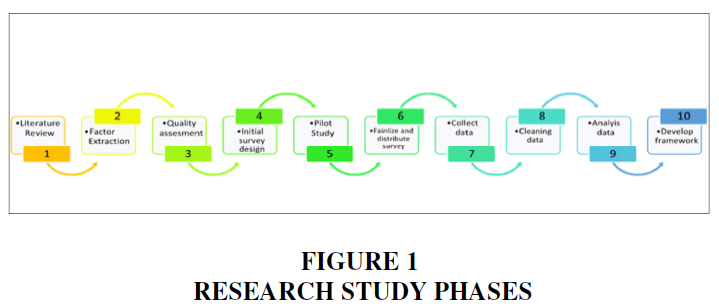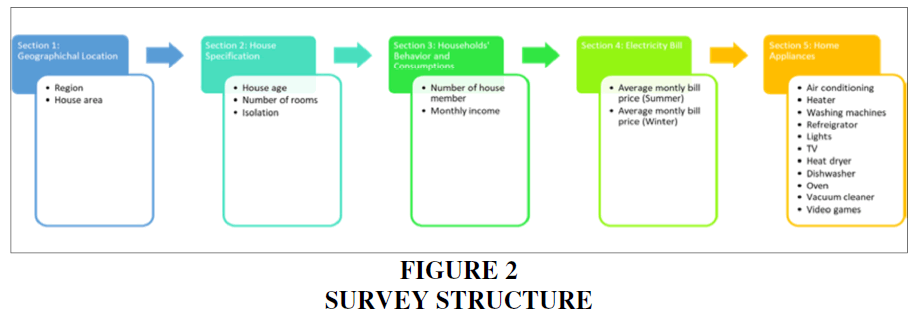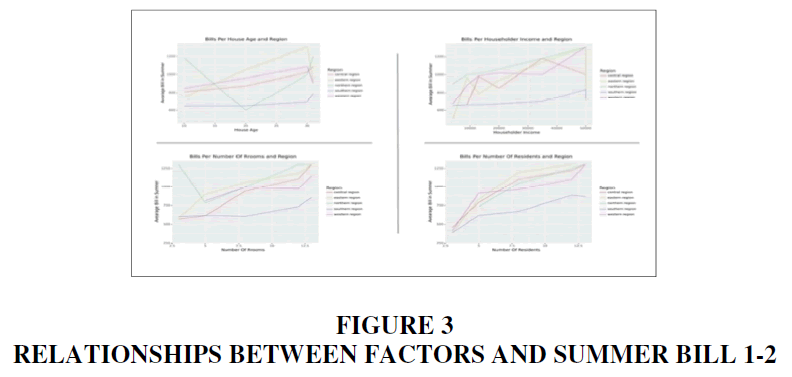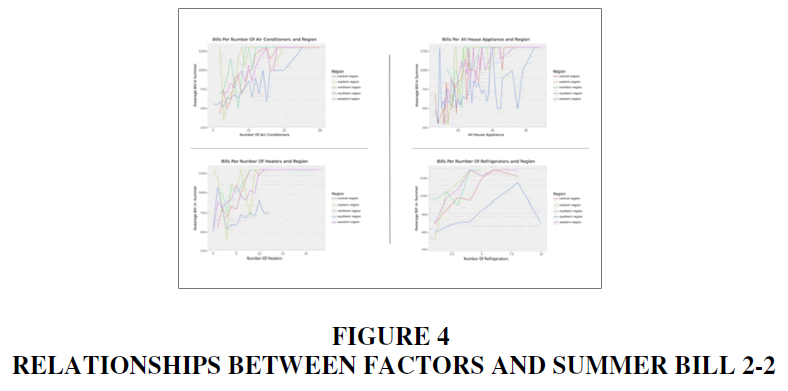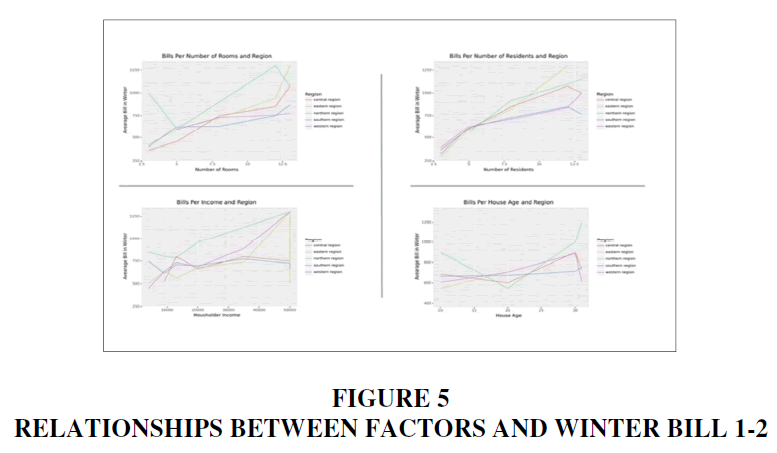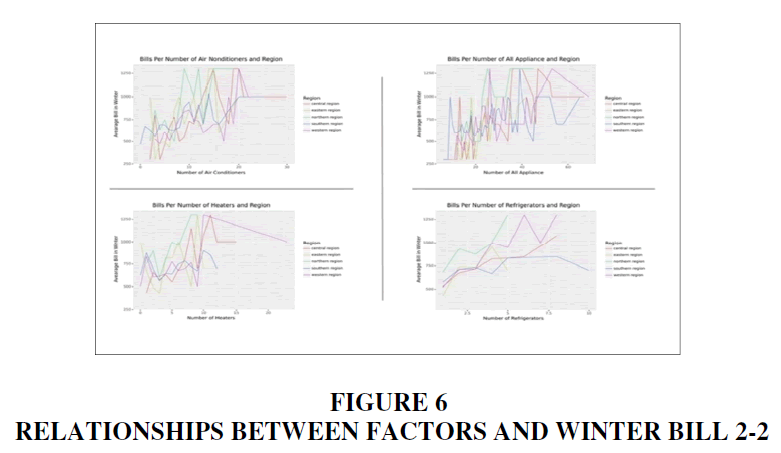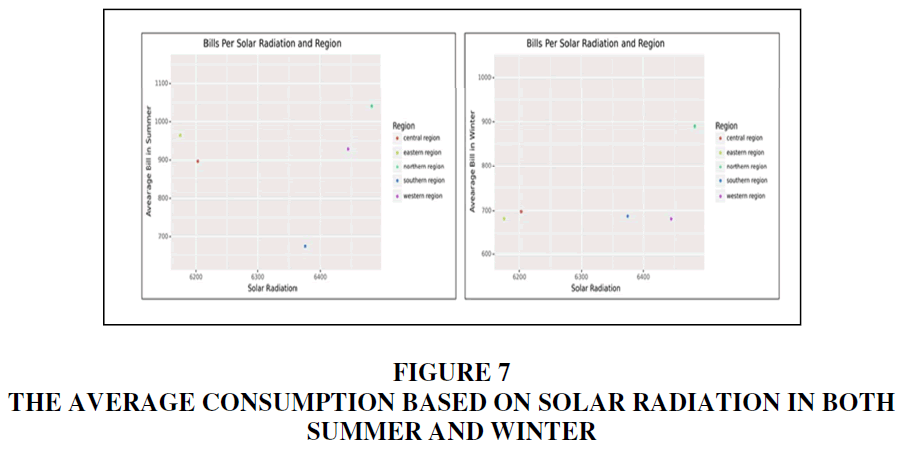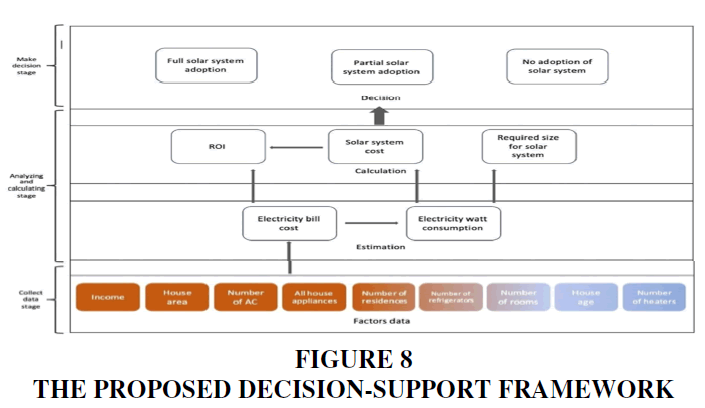Research Article: 2023 Vol: 26 Issue: 1S
DEVELOPMENT OF A DECISION-SUPPORT FRAMEWORK OF FACTORS AFFECTING SOLAR SYSTEM INSTALLATION IN SAUDI ARABIA
Rahaf A Alsuhemi, King Abdulaziz University
Shahad M Alsaedi, King Abdulaziz University
Soha M Zarbah, King Abdulaziz University
Hind Bitar, King Abdulaziz University
Bahjat Fakieh, King Abdulaziz University
Citation Information: Alsuhemi, R.A., Alsaedi, S.M., Zarbah, S.M., Bitar, M. & Fakieh, B.. (2023). Development of a Decision-Support Framew ork of Factors Af fecting Solar System Installation in Saudi Arabia. Journal of Management Information and Decision Sciences, 26(S1), 1-15.
Abstract
The residential sector is one of the most energy-consuming sectors in Saudi Arabia. As the issue arose, the government of Saudi Arabia realized the possible negative consequences and started to set plans to empower alternative clean energy sources. Solar energy could be one of the most efficient types of renewable energy production in Saudi Arabia due to its geographical nature. Despite this, homeowners in Saudi Arabia need assistance to decide on the adoption of the solar system as an energy source; this is due to their lack of knowledge of the factors that can affect the solar energy system. This fact became evident in the actual number of solar energy users, which is no more than 1.6%. This research paper aims to investigate the factors that affect homeowners' decisions to switch to solar energy in Saudi Arabia. From 418 homeowners' responses, the analysis revealed that the most significant factors affecting the consumption bill are the house age and area, the number of rooms and residents per house, household income, and the number of refrigerators, heaters, and air conditioners. These factors are then used to develop a framework that would help individuals decide whether to use solar energy or to stay and use traditional electrical power.
Keywords
Decision-Support Framework, Solar System Installation.
Introduction
In recent years, the global demand for renewable energy is growing due to the increasing population and electricity consumption (Renewable Energy, 2021). The excessive use of electricity has led to a rise in global warming, which has also led to serious environmental and energy problems (Lu et al., 2020). According to Emissions nearly two-thirds of all CO2 emissions come from the energy sector, which is causing global concern Emissions Consequently, the world's attention has been turning to generate energy from clean and renewable sources (Mosaad et al., 2019). Renewable energy can be generated from natural environmental sources such as solar energy, wind energy, and water energy. In 2018, renewable energy accounted for 26.2% of worldwide power generation. By 2040, the rate is anticipated to climb to 45%. Solar, wind, and hydropower are anticipated to account for the majority of the energy growth (Renewable Energy, 2021).
During the last five years, the Saudi Arabia government has given a high priority to the transformation to renewable energy generation. It is an essential goal of the Saudi Vision 2030, with the aim of producing up to 9.5 gigawatts of electricity by 2023. Indicators of Renewable Energy in Saudi Arabia 2017. Therefore, Saudi Arabia has taken serious steps to shift toward renewable energy by launching the National Renewable Energy Program (NREP) which is supervised by the Ministry of Energy (MOEnergy). This program aims to reduce the use of oil as a primary source of energy and increase the production of renewable energy (Abdel-Baky & Garcia, 2021). Among the various renewable energy sources, there is a great opportunity to benefit from solar energy solutions in the Kingdom of Saudi Arabia due to the characteristic climate and geographical location. Statistically, the average daily solar radiation is 5.2 kilowatts /m2, and the annual average is over 2118 kilowatts/m2 (Qattan & Bakri, 2021).
Since the residential sector has a significant influence on electricity consumption, it must be central in the renewable energy transformation plan. Saudi Arabia revealed that the residential sector's consumption of electricity in 2010 was 109,021 GWh, while in 2018 it was 130,428 GWh, which constitutes 43% of the total consumption rate (Indicators of Renewable Energy in Saudi Arabia 2017. This growing demand prompted the Saudi government to adopt legislation to allow homeowners to use solar energy sources as a full or partial alternative to the traditional electrical power in their homes. Even though more than 50% of Saudi homeowners are interested in using solar energy to generate household electricity, there is a lack of individual knowledge about the factors affecting the solar energy system (Total Electrical Energy Consumption, 2021). Moreover, there are many misconceptions held by individuals in this regard. Most notably, they believe that using solar energy has always been an economically efficient solution. Indeed, the effectiveness of the solar energy system is influenced by many factors, and it may have negative economic effects on the homeowner in some cases (Alqahtani & Balta-Ozkan, 2021).
The purpose of this research study is to shed light, identify, and analyze the main factors that affect the individuals' decision to move toward solar energy. Designing and developing a decision-making framework would help individuals in making the right decision of whether to use solar energy or to stay and use traditional electrical power. The usefulness of this framework can aid both current homeowners and those who are planning to build or own a home, which is the contribution of this study. Section 2 focuses on the literature related to this study to explore and discuss factors in more detail. Section 3 illustrates the methodology of this research. Section 4 presents and discusses the results, and Section 5 concludes the work.
Literature Review
The Feasibility of Rooftop Solar Panels in the KSA
The building's roof is the best and most common area to install solar panels because of its direct connection to the sun, rainfall, and the environment Movahhed. Therefore, several studies have focused on the feasibility of rooftop solar panels in the building sector in Saudi Arabia. In this regard, the investigation takes three aspects into consideration, which are: the economic feasibility in terms of the amount of energy produced and the percentage of financial savings; the city and its climate in which the case study was applied; and the type of building, as it is closely related to the amount of energy consumption. In terms of cities, this investigation takes place throughout Saudi Arabia: northerly in Neom and Arar, westerly in Jeddah, and Riyadh in the central region. It also covers several types of buildings including residential buildings (apartments, villas, duplexes, and traditional houses), schools, and mosques.
In 2021, Qattan and Bakri carried out a case study on a duplex villa in Jeddah. The authors made a simulation of the building using the DesignBuilder program. The simulation results showed the high feasibility of installing solar panels on the roof, as they met more than a quarter of the energy consumption during the year (Qattan & Bakri, 2021). Another analysis conducted in NEOM aimed to find the best way to make NEOM a city with net-zero energy buildings (Alqahtani & Balta-Ozkan, 2021). The study relied on simulation systems as well, using the Homer Pro program. The analysis concluded that the use of solar panels is feasible in terms of energy production, as the production reached approximately 68% of the total consumption. However, in terms of economic feasibility, they had another opinion; they found that the system was not economically feasible with the current tariff of electricity in Saudi Arabia, which is $0.06 kWh. The study suggested using the Chinese electricity tariff of $0.08 kWh to make the project economically feasible. Based on the studies reviewed in this field, the lack of economic feasibility is due to the use of batteries in the solar system, which raises the total cost of the system (Alqahtani & Balta-Ozkan, 2021).
In the school sector, a study was conducted in the city of Arar, aiming to provide a new approach to the design and construction of school buildings (Alfaraidy & Sulieman, 2019). A school building was selected to study energy consumption in detail. The study concluded that the use of the solar energy system was economically feasible, as it saved approximately 99,201 SAR out of 138,681.3 SAR in the total annual electric bills (Alfaraidy & Sulieman, 2019). A technical-economic analysis was conducted in 2017 on the roof of a mosque in Riyadh (Elshurafa et al., 2019). This analysis includes the study of the feasibility of the solar energy system with consideration of the Net Energy Metering Mechanism (NEM). NEM allows homeowners who produce their own electricity with solar systems to sell their surplus energy back to the grid in exchange for credit. They found that the bill would be cut in half if some advance planning were incorporated into the early stages of building the mosque. Moreover, the solar energy system could reduce the electricity bill to zero. All previous studies prove the economic and technical feasibility of solar energy systems on the roofs of buildings. In addition to the findings in these studies, the solar energy system is supported by the Saudi government (Elshurafa et al., 2019).
Factors Affecting Solar System
The factors affecting the solar energy system are closely related to the factors that affect the consumption of electricity. Several studies have been conducted to analyze the factors that influence household electricity consumption and the cost of electricity bills. These studies have also recommended and suggested several strategies to mitigate consumption to improve usage and lower costs. This section in this regard explains which factors have the most significant impact on electricity consumption.
A study was conducted to investigate the factors that influence household electricity expenditure in Palestine, focusing on the relationships between monthly income, the number of family members, bedrooms, rooms, and household electricity expenditure (Abdel & Ayyash, 2019). According to the author, the number of bedrooms and rooms, total expenditure on goods and services, monthly income, and the number of family members are all positively connected with housing electricity spending. Also, looking at the type of material used in the construction of external walls, the analysis concluded that houses that adopt concrete in constructing exterior walls have the lowest electricity expenditure. Thus, the material used in construction is also considered another factor that influences household electricity expenditure (Abdel & Ayyash, 2019). In 2020, a quantitative study was conducted to analyze and discover the domestic consumption factors and energy usage intensity to create prediction models (Awan & Knight, 2020).
The findings suggested that knowing the number and types of appliances and lights, their installed power ratings, the number of air conditioned rooms, and their area (focusing on cooling) can considerably forecast annual electricity demand per family and capita (Awan & Knight, 2020). Another study that was conducted in China proposed a method to determine the most important variables from many potential effect factors on energy consumption (Yu et al., 2017). A wrapper feature picking model based on a genetic algorithm was used to determine the main factors of home electricity consumption levels and understand their effect mechanisms. The result had shown that the number of bedrooms was an essential factor in determining the variation in power consumption, while the gender of the householder had a minimal effect. The occupancy hour and frequency of appliance use increased as the household size grew. In addition, the number of people under the age of 15 was the second major factor positively associated with household power usage (IEA, 2019). Residential electricity consumption appeared to be lower in households occupied by intellectuals than in homes occupied by family members with no formal education. The impact of high electrical energy demand increased as the total number of gaming consoles and televisions increased in the appliance subgroup. Households who cooked or heated using electricity were found to be about two times more likely to be high electricity consumers than those who cooked or heated with other energy sources (Yu et al., 2017).
A study that aimed to investigate the factors of household electricity consumption was conducted in Korea (Kim, 2020). This study utilized both Ordinary Least Squares (OLS) and quantile regression to analyze the factors that influence power consumption. The findings revealed that the impacts of socio-demographic, housing, and electrical consumption factors on household electricity consumption varied between two regressions and among quantiles. In all quantities, they discovered that the age of the household head, the number of households, the dwelling area, the refrigerator usage time, and the number of household appliances were significant and increased electricity consumption (Kim, 2020). This was similar to the findings in another study looking at the models and factors related to economic, socio-demographic, and building characteristics for estimating electricity consumption in residential buildings in London (Gassar et al., 2019). The analyzed factors which were determined in this new study as the most influential in consumption were building properties, household income, appliances, and rooms (Gassar et al., 2019). Two statistical models were built to address the most significant factors influencing electricity consumption in Greece (Kotsila & Polychronidou, 2021). The major factors with a high impact in this study were the number of residents, the size of the house, the type of heating, the heating and cooling hours, and the weather conditions (Kotsila & Polychronidou, 2021). Both urban and non-urban household electricity use and the factors associated with them were examined in Sri Lanka (Suresh, 2019). The findings demonstrated that factors such as school year, household size, home attributes, and household appliances significantly impacted power consumption (Suresh, 2019). A study analyzed residential building electrical consumption patterns in the Kingdom of Saudi Arabia, concentrating on the Al-Qassim region (Esmaeil et al., 2019). The analysis revealed that the building has little influence on household energy consumption, except for villas, which have a higher consumption during the hot summer season. Occupant behaviors and meteorological circumstances also influenced consumption and the technical conditions of both building envelopes and air conditioners, setting the temperature point. Table 1 illustrates the factors considered by the studies. Almost all of them agreed on the following significant factors: house size, number of household members, rooms, income, and use of appliances (Esmaeil et al., 2019).
| Table 1 Factors Affecting Solar System | ||
| Factors | The Effect of The Factor on Energy Consumption | Reserach Studies that Considered These Factors |
| House Size | With increases in house's area, the consumption of electricity would increase. If the square meter area increases by 1m2, the monthly consumption will increase by 1.389 kWh, and the yearly consumption will increase by 0.3 | (Abdel & Ayyash, 2019; Awan & Knight, 2020; Esmaeil et al., 2019; Kim, 2020; Kotsila & Polychronidou, 2021; Suresh, 2019) |
| Number of Household Members | The number of family members is associated with the expenditure on electricity at home. It would raise the occupancy hour and frequency of appliance use. | (Awan & Knight, 2020; Esmaeil et al., 2019; Gassar et al., 2019; Kim, 2020; Kotsila & Polychronidou, 2021) |
| Number of Rooms | The number of rooms in the house has a considerable impact on energy consumption, requiring more home applications. Since the number of rooms in a house increases by 1%, the electricity expenditure increases by 9.8%. | (Abdel, 2019; Awan and Knight, 2020; Kim, 2020; Kotsila and Polychronidou, 2021) |
| Monthly income | Household income has a significant and positive impact on power usage as it is associated with more extensive, warmer houses with more appliances. The studies indicated that when monthly income rises by 1%, power usage increases by 4.9%. | (Awan & Knight, 2020; Gassar et al., 2019; Kim, 2020; Kotsila & Polychronidou, 2021) |
| Number of bedrooms | The number of bedrooms has the most significant impact on the difference in electricity consumption. Bedrooms would increase the need for lighting, heating, and cooling in each room in dwellings. | (Abdel & Ayyash, 2019) |
| Geographical location | Electricity consumption may vary depending on region, geographic location, and climatic conditions. | (Abdel & Ayyash, 2019; Esmaeil et al., 2019; Suresh, 2019) |
| Expenditure on electricity (Bill) | The amount consumed and the severity to which the cost is influenced by changes in energy consumption. | (Abdel & Ayyash, 2019; Awan & Knight, 2020; Esmaeil et al., 2019) |
| Number of appliances and hours used * | Electricity consumption is greatly influenced by the number of household applications and the number of hours used per day. | (Awan and Knight, 2020; Kim, 2020; Suresh, 2019) |
| Electricity uses per month(kWh) | The amount of consumption is expressed in kilowatts. | (Awan & Knight, 2020; Esmaeil et al., 2019; Kim, 2020) |
| House material type and age | The results revealed that the house varies in consumption from one type to another. Depending on the surface and floor type, the cooling and heating system consumption varies. Also, older houses consistently consume more energy than new houses | (Abdel, 2019; Esmaeil et al., 2019; Kotsila & Polychronidou, 2021) |
| Sex and age of householder's members | The age of the head of the home may aid in reducing or increasing energy consumption. For example, the number of people under 15 is a significant factor positively associated with electricity consumption. | (Kim, 2020; Kotsila & Polychronidou, 2021) |
| Educational level | The residential power consumption level of high educational households appears to be lower than low educational households. | (Kim, 2020; Kotsila & Polychronidou, 2021; Suresh, 2019) |
| Floor | Floor variations may result in varying energy consumption and requirements from one floor to another. | (Kotsila & Polychronidou, 2021) |
| Type (villa, flat) | Villas have somewhat higher consumption during the hot summer season. | (Esmaeil et al., 2019; Kotsila & Polychronidou, 2021) |
| Isolated materials | The use of isolation materials reduces energy consumption while also enhancing the efficiency of electrical appliances. | (Esmaeil et al., 2019) |
Methodology
The main aim of this research study is to design and develop a decision-making framework that would help individuals in making the right decision of whether to use solar energy or to stay and use traditional electrical power. To reach this aim, this study followed a phased approach (as shown in Figure 1). As a first step, it relied on the literature review to extract the influencing factors. Then, a quantitative approach was used to collect data. Hence, statistical methods were applied to analyze the data. These phases will be discussed in detail in the following subsections.
Search Strategy
The research process followed a defined and sequential three-stage approach of literature review, factor extraction, and quality assessment. In the literature review stage, several free-access search engines were used (IEEE Xplore and Google Scholar) to search for relevant and recent studies. Basically, the researchers of this study focused on studies over the past 3 years (2019-2021) to maintain up-to-date information. The selection of studies depended on the following criteria: direct relevance of the study, recent publication date, clarity of the inferred factors, and their impact. The literature included studies that were conducted in the investigation of geographical, behavioral, and environmental factors that affect energy consumption, electricity bills, and solar system efficiency. This search was based on several key terms, including “electricity consumption factors”, “Household Electricity Analysis”, “Electrical energy consumption”, “residential electricity consumption analysis”, “Analyze factors of household electricity consumption” and “Statistical analysis for factors affecting energy consumption”. The references of the selected studies were also searched to ensure the comprehensiveness and accuracy of the research.
In the extraction stage, the literature and extracted the factors were manually reviewed. To enhance the accuracy, two investigators independently conducted the data extraction (S.R. & Z.S.) and then the extracted data were compared. As a result, a list of well-known and well-tested factors was created, in addition to the effects of each factor and the extents of their impact. The extracted factors are the basis for this research; thus, the process of evaluating their quality is essential. In the quality assessment stage, two electrical engineers with more than 10 years of experience in their field were interviewed, and the data from these interviews was presented for assessment. The experts expressed their agreement on these factors, and they also added some other factors that would improve the results of the study, such as "the electric tariff has an important role in the cost of electricity."
Survey
To collect relevant data, an online quantitative survey which aims to understand the extracted factors and its impact on energy consumption was created and published. The data was collected from 418 homeowners from the various regions of Saudi Arabia previously mentioned. Based on the target audience of the survey, the survey was developed in Arabic. This survey's study population included the owners of Saudi residents to collect the required data. The study population included the owners of all types of residential units in Saudi Arabia, including those owning villas, apartments, and popular houses with a total of 2,285,786 houses. Yamane’s formula (1) was used to calculate the required sample size (Adam, 2020).

Where n is the required sample size, e is the precision level, and N is the population size. Yamane's equation was applied using the following identifiers: N=2285786 and e= ± 5% where it is an acceptable precision rate in the social research Taherdoost, 2017. It was concluded that to achieve the required precision level, the sample size must not be less than 400. Consequently, the study sample consists of 418 homeowners from the various regions of Saudi Arabia.
Survey questions are designed to study and understand the extracted factors and its impact on energy consumption. The factors were classified into 5 groups according to the relationships between them: "Geographical Location Factors", "House Specification Factors", "Households' Behavior and Consumption Factors", "Electricity Bill Factor", and "Home Appliance Factors". According to this classification, the survey consists of 5 sections each, including questions about related factors belonging to the same classification. The survey is based on closed-ended questions, the majority of which are multiple-choice questions (11 out of 17), and the rest are short answer questions (6 out of 17). Figure 2 illustrates the survey structure. The survey was evaluated by an assistant professor with more than 5 years’ experience in the research field. Then, a pilot study was conducted which involved 15 homeowners of the target audience. They answered the survey and were asked 3 questions for the purpose of evaluation, which are, “Are the questions direct and explicit?”, “Are the questions clear and understandable?” and “Are the questions easy to answer?” The results obtained indicate that the questions were straightforward, clear, understood, and easy to answer, where 86% answered yes to the first two questions, and 93% found that the questions were easy to answer. However, through the direct contact with the participants, the researchers of this study realized that the answerability increased when the survey starts with the easiest questions. Consequently, the order of some questions in the survey was changed (Question Pro, 2021).
Data Analysis
The data were collected, initially processed, and handled by Microsoft Excel. Then, the collected data were cleaned, prepared, and analyzed using the Jupyter web tool with the Python analytical libraries. In the cleaning stage, the columns that matched keywords in the Python language were changed, the Replace function was used to convert devices list items to a number that represents the length of the list, and the loc method was used to change the extreme values in the area's column. An exploratory and statistical analysis was conducted to explore the relationships between the factors. The goal of the exploratory analysis was to explore and investigate the relationship using visualizations and graphics. Based on the resulting relationships, the Correlation coefficient method was applied. Correlation coefficients were conducted to measure relationships between the factors and the consumption bill. A correlation analysis is a statistical technique that measures the relationship's strength and direction between two variables and measures their association (Correlation analysis: Analyze correlation between two variables, n.d.). Considering the correlation coefficient varies from + 1 into 0 to – 1, a high correlation between 0.4 points to 1 point indicates a strong relationship, whereas a low correlation indicates a weak relationship. Two methods of correlation were applied: Spearman and Pearson. The difference is that in Spearman, the factors tend to change concurrently, but not certainly at a constant rate.
Results
The consumption bill for both the summer and the winter seasons is the main factor and the base of the analysis, so it is considered as the base factor. The exploratory and statistical data analysis proves that the factors that affect the consumption bills the most are house age, the number of rooms and residents per house, the household income, and the number of refrigerators, heaters, and air conditioners. The relationship between the bill cost and the house age, the income, the number of rooms, and the number of residents in the summer is illustrated in Figure 3.
Also, Figure 4 represents the relationship between the number of air conditioners, heaters, refrigerators, and all appliances' factors with the summer bill. As observed from the line, the increase in the number of devices increases the cost of the bill. This is due to the increase in the number of devices causing an increase in watt consumption.
The winter bill is also affected by the same factors but at a lower rate than the summer bills. The relationship of house age, income, number of rooms, and residents with winter bills is shown in Figure 5.
Continually with the winter bill, the number of air conditioners, heaters, refrigerators, and all appliances’ relationships are represented in Figure 6. The analysis results for the appliances in the winter are rather ambiguous because the increasing rate is not constant.
This ambiguity appears clearly in the top two figures (Figures 5 and 6) because people vary in using air conditioning in the winter; this led to mixed results, which affected the relationship result of all devices. In comparison, the relationship of refrigerators and heaters was more apparent because of the permanent use of refrigerators and the increased use of heaters during the winter.
As it turns out, each region has a different consumption rate depending on its solar radiation. Figure 7 shows the average consumption based on solar radiation in both the summer and the winter for each region. It is shown that the southern region has a lower consumption bill cost in the summer, along with the eastern and western regions in the winter, whereas the northern region has the largest consumption bill cost in both the summer and the winter.
After studying the relationships between the factors and their impact on the main factor, which is the consumption bill, the second stage in the analysis was to find out the extent of influence for each factor using correlation analysis. Two methods of correlation were applied: Pearson and Spearman. According to these methods, all of the significant factors mentioned above have shown a positive relationship with the bill cost. The results of the positive relationship were higher in the Spearman than in the Pearson correlation. However, both revealed that the income, house area, air conditioners, all appliances, and the number of residents all have a very high positive rate with the bill cost.
Homeowner income is a significant factor that affects the bill cost; the analysis revealed that it also affects almost all other factors. Thus, if the income increases, it increases the number of rooms and residents, home appliances and different lighting types. Using the results obtained from factor analysis, this paper’s researchers studied the factors considering the solar energy system aspect and discovered what factors could affect the individual’s decision to switch to the solar energy system. Basically, the solar energy system has three parameters that must be taken into consideration before deciding. The following subsections explain each of these parameters and the factors related to them.
Space to Install the System
In general, the required size of the solar system depends on the solar radiation of the geographical location, as it is measured in Kwh/m2. For example, a square meter in the north of Saudi Arabia can produce an amount of energy that differs from a square meter in the south. However, the results of the analysis showed that solar radiation is not the only influencing factor. The required size of the solar system is also closely related to two other factors: the electricity bill and the house size. The higher the cost of the consumption bill, the larger the required solar system size. As for the house size factor, according to Saudi regulations issued by the Ministry of Municipal and Rural Affairs and Housing (MMRAH), the solar energy system must be installed on the roof area of the house, provided that a distance of 1 meter is left from the walls from all sides (Ministry of Municipal, Rural Affairs and Housing, 2021). Thus, the available space on the roof affects the possibility of installing the solar energy system, thus explaining how the house size factor can influence the decision.
The Total Cost of the System
As in the required size, the total cost of the solar energy system is influenced directly by the cost of the consumption bill. The higher the rate of consumption, the greater the total cost of the system to meet consumption needs. Going back a step, the cost of the electricity bill itself is affected by the income, as was evident in the results of the analysis. Thus, it can be concluded that the individual's income is one of the biggest factors that affect the decision to switch, because it is reflected on the individual's ability to meet the cost and requirements of the system. It also has an implicit effect on the value of the bill, as mentioned earlier in the results of the analysis.
Economic Savings
To find out the extent of the economic savings that the solar energy system will achieve, the return on investment (ROI) should be calculated. The ROI value depends on two factors: the value of the annual electricity bill, and the total set-up cost of the system. As mentioned earlier, the lifetime of the solar energy system is 25 years. So, if the result of dividing the set-up cost on the annual bill is less than 25, then the electric energy for the remaining years until the end of the lifetime of the system is reached is free. According to the studied sample, the ROI results ranged from 7 to 23 years; this disparity was due to the difference in the annual consumption. Last but not least, the geographical area plays a major role in influencing the decision of individuals. For example, as previously shown in the results of the analysis, homeowners in the southern region have a lower consumption rate than those in the other regions (see Figure 8). Thus, geographical area will also affect the system set-up cost and the value of the ROI. To prove the variation that this factor can make, Table 2 shows an example from the studied sample of homeowners from each region of Saudi Arabia. Although they have the same house area, they differ in the cost of the consumption bill, and therefore the value of the ROI.
| Table 2 Sample from Each Region of Saudi Arabia | ||
| Region | House Area (m2) | ROI |
| Southern Region | 300 | 7 |
| Northern Region | 300 | 15 |
| Eastern Region | 300 | 13 |
| Central Region | 300 | 13 |
| Western Region | 300 | 11 |
Moreover, following the previous analyses and calculations, the main aim of the research is to develop a framework that assists the decision-making of those who are going to purchase or own a house to either install a solar system in full or in part, or not to adopt it at all. Thus, the proposed decision-support framework in Figure 8 illustrates the stages that individuals should go through before deciding. The first stage is to collect data related to the factors affecting the bill in a specific area. These factors were arranged in a framework according to the strengths of their influence from high to low. The next stage is to analyze and calculate data in order to come up with a bill estimate. Individuals would compute watt usage, solar system size, cost, and ROI based on this information. The last stage involves decision-making, based on the outcomes of the preceding stages.
Discussion and Future Works
All homeowners could estimate the cost of the solar energy system and whether it is affordable and suitable for their budgets or not, but for those who do not yet own a house, this estimation may be a rather frustrating and hard process. Thus, the novelty of this research comes down to where the usage of the proposed decision-support framework would assist people who do not yet own a house in estimating the bill and then making a decision to adopt or not adopt a solar energy system. The results indicate that there are significant factors that affect the bill cost; that means when these factors increase, electricity bill cost will also increase. Consequently, it affects the decision of whether to adopt the solar energy system or not.
In line with the previous research, this study’s finding was similar to those in some of the previously mentioned studies, where some of these factors were considered to be significant and positively affecting the electricity bill, such as house age (Fikru, 2019), household income (Guta, 2018). Moreover, these factors were classified according to their affecting priority from most to least. Factors included in other research such as sex and age of house members (Kim, 2020; Kotsila & Polychronidou, 2021; Yu et al., 2017), and their education level (Kim, 2020; Kotsila & Polychronidou, 2021; Suresh, 2019; Yu et al., 2017) were not considered as significant factors. Therefore, they were not included and studied in this research. Additionally, some of these research studies were conducted in rural areas (Guta, 2018) and some in well-known cities and countries (Alam et al., 2021; Alqahtani & Balta-Ozkan, 2021; Esmaeil et al., 2019; Parkins et al., 2018). However, other recent previous studies were focusing on understanding the factors that affect the intention among households about the usage of photovoltaic solar technology. Examples of the extracted factors were cost awareness and governmental initiatives (Alam et al., 2021). Other factors were consumer innovativeness, as well as perceived value Angowski.
As for the aim of this study in producing a framework that will help in deciding about solar system adoption, the study’s researchers aspire to turn this idea into an intelligent system that helps decision-making without relying on prior bills. Thus, to achieve that, further studies should consider the different types of solar energy systems and their variable costs.
Adapting solar energy has several benefits, one of which is to increase the community's resilience to any power outages or disasters (Patel et al., 2021).
Conclusion
Therefore, this research paper studied and analyzed the factors affecting electricity consumption in the Saudi residential sector and how these factors can guide individuals to adopt solar energy or to continue using traditional electrical power. The analysis conducted on data collected from 418 homeowners has shown that the factors affecting the consumption bills the most are house age, number of rooms and residents per house, household income, number of refrigerators, heaters, air conditioners, and the geographical location. Furthermore, the Pearson and Spearman coefficient analysis showed that the factors with a very high positive rate are income, house area, air conditioners, all appliances, and the number of residents. Based on the analyzed factors, the framework was designed and developed as a guideline to be helpful to current homeowners and to those planning to build or own a home. The framework consists of three stages: collecting data, analyzing and calculating, and making decisions stages. Future studies will use the proposed framework as a base to build an intelligent prediction system.
References
Abdel, J.Y., & Ayyash, I. (2019). Analysis of household expenditure on electricity in Palestine. 9(5), 237–243.
Indexed at, Google Scholar, Cross Ref
Abdel-Baky, M., & Garcia, M. M. (2021). ICLG. Renewable Energy Laws and Regulations Saudi Arabia 2022.
Adam, A. M. (2020). Sample size determination in survey research. Journal of Scientific Research and Reports, 26(5), 90–97.
Alam, S.S., Ahmad, M., Othman, A.S., Shaari, Z.B.H., & Masukujjaman, M. (2021). Factors affecting photovoltaic solar technology usage intention among households in Malaysia: Model integration and empirical validation. Sustainability, 13(4), 1773.
Indexed at, Google Scholar, Cross Ref
Alfaraidy, F.A., & Sulieman, H.A. (2019). The economics of using solar energy: school buildings in Saudi Arabia as a case study. ARO-The Scientific Journal of Koya University, 7(1), 13-18.
Indexed at, Google Scholar, Cross Ref
Alqahtani, N., & Balta-Ozkan, N. (2021). Assessment of Rooftop Solar Power Generation to Meet Residential Loads in the City of Neom, Saudi Arabia. Energies, 14(13), 3805.
Indexed at, Google Scholar, Cross Ref
Awan, U., & Knight, I. (2020). Domestic sector energy demand and prediction models for Punjab Pakistan. Journal of Building Engineering, 32, 101790.
Indexed at, Google Scholar, Cross Ref
Elshurafa, A.M., Alsubaie, A.M., Alabduljabbar, A.A., & Al-Hsaien, S.A. (2019). Solar PV on mosque rooftops: Results from a pilot study in Saudi Arabia. Journal of Building Engineering, 25, 100809.
Indexed at, Google Scholar, Cross Ref
Esmaeil, K.K., Alshitawi, M.S., & Almasri, R.A. (2019). Analysis of energy consumption pattern in saudi arabia’s residential buildings with specific reference to qassim region. Springer, 12, 2123–2145.
Indexed at, Google Scholar, Cross Ref
Fikru, M.G. (2019). Estimated electricity bill savings for residential solar photovoltaic system owners: Are they accurate enough?. Applied Energy, 253, 113501.
Indexed at, Google Scholar, Cross Ref
Gassar, A.A.A., Yun, G Y., & Kim, S. (2019). Data-driven approach to prediction of residential energy consumption at urban scales in London. Energy, 187, 115973.
Indexed at, Google Scholar, Cross Ref
Guta, D.D. (2018). Determinants of household adoption of solar energy technology in rural Ethiopia. Journal of Cleaner Production, 204, 193-204.
Indexed at, Google Scholar, Cross Ref
IEA, G.E. (2019). CO2 Status Report 2018. International Energy Agency, Paris, 562.
Kim, M. J. (2020). Understanding the determinants on household electricity consumption in Korea: OLS regression and quantile regression. The Electricity Journal, 33(7), 106802.
Indexed at, Google Scholar, Cross Ref
Kotsila, D., & Polychronidou, P. (2021). Determinants of household electricity consumption in Greece: a statistical analysis. Journal of Innovation and Entrepreneurship, 10(1), 1-20.
Indexed at, Google Scholar, Cross Ref
Lu, H., Guan, Y., He, L., Adhikari, H., Pellikka, P., Heiskanen, J., & Maeda, E. (2020). Patch aggregation trends of the global climate landscape under future global warming scenario. International Journal of Climatology, 40(5), 2674-2685.
Indexed at, Google Scholar, Cross Ref
Ministry of Municipal, Rural Affairs and Housing. (2021). GOV.SA.
Mosaad, M.I., abed el-Raouf, M.O., Al-Ahmar, M.A., & Banakher, F.A. (2019). Maximum power point tracking of PV system based cuckoo search algorithm; review and comparison. Energy Procedia, 162, 117-126.
Indexed at, Google Scholar, Cross Ref
Parkins, J.R., Rollins, C., Anders, S., & Comeau, L. (2018). Predicting intention to adopt solar technology in Canada: The role of knowledge, public engagement, and visibility. Energy Policy, 114, 114-122.
Indexed at, Google Scholar, Cross Ref
Patel, S., Ceferino, L., Liu, C., Kiremidjian, A., & Rajagopal, R. (2021). The disaster resilience value of shared rooftop solar systems in residential communities. Earthquake Spectra, 37(4), 2638-2661.
Indexed at, Google Scholar, Cross Ref
Qattan, W.S., & Bakri, A.A.Y. (2021). Renewable Energy Technologies in Residential Buildings in Hot Humid Regions and Their Implications Case Study: Jeddah City. Design Engineering, 1298-1312.
Question Pro. (2021) Correlation Analysis.
Renewable Energy. (2021). [Center For Climate and Energy Solutions]. Renewable Energy.
Suresh, K. (2019). Factors Associated with Household Electricity Consumption Expenditure in Sri Lanka.
Total Electrical Energy Consumption. (2021). General Authority for Statistics.
Yu, Y., Wang, B., Wang, Z., Wang, F., & Liu, L. (2017). Wrapper feature selection based multiple logistic regression model for determinants analysis of residential electricity consumption. In 2017 Asian Conference on Energy, Power and Transportation Electrification (ACEPT), 1-8.
Received: 04-Sep-2022, Manuscript No. JMIDS-22-12507; Editor assigned: 06-Sep-2022, PreQC No. JMIDS-22-12507(PQ); Reviewed: 19- Sep-2022, QC No. JMIDS-22-12507; Revised: 21-Sep-2022, Manuscript No. JMIDS-22-12507(R); Published: 26-Sep-2022
